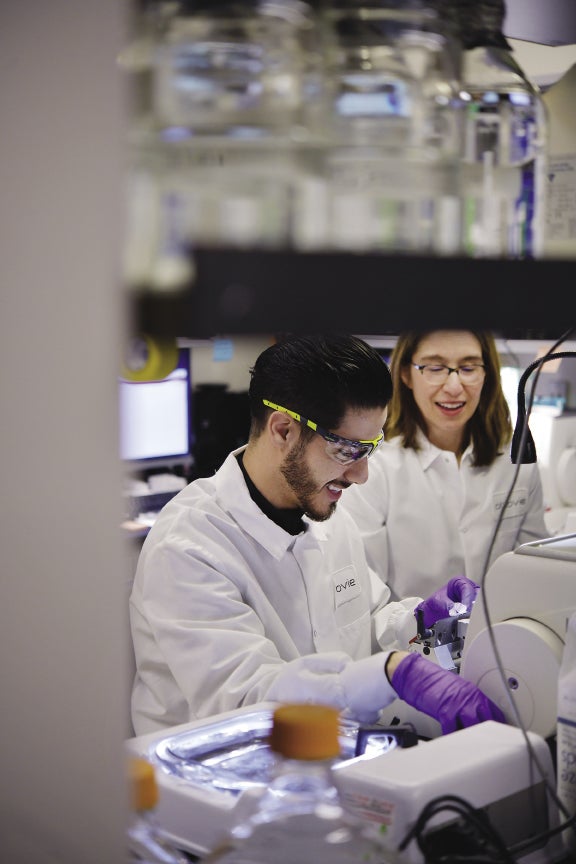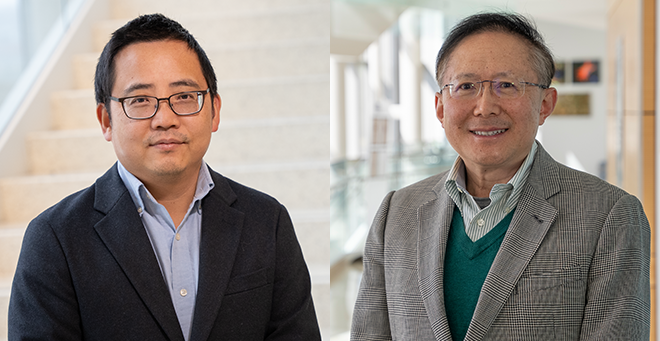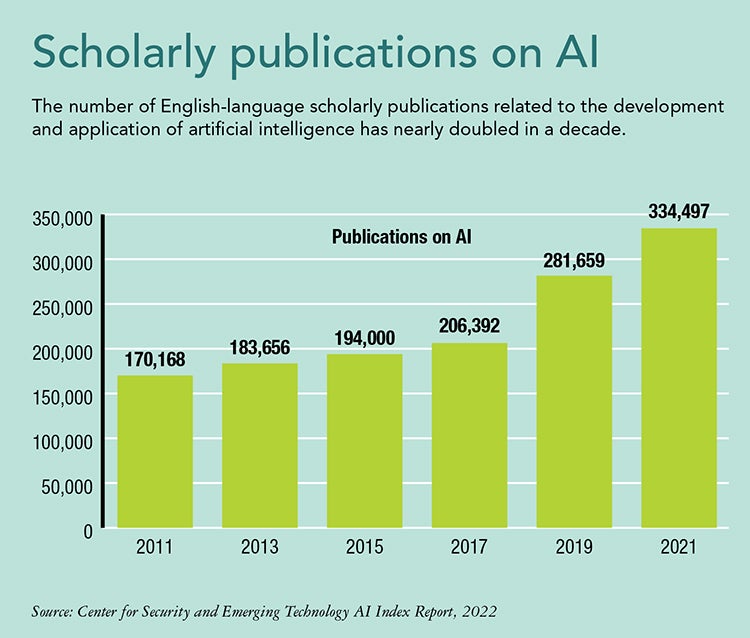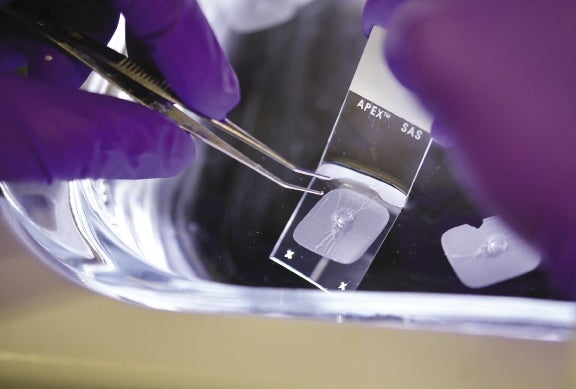Researchers across Central Mass. are leading development of cutting-edge ideas and therapies to provide the next generation of solutions to present and future problems.
Get Instant Access to This Article
Subscribe to Worcester Business Journal and get immediate access to all of our subscriber-only content and much more.
- Critical Central Massachusetts business news updated daily.
- Immediate access to all subscriber-only content on our website.
- Bi-weekly print or digital editions of our award-winning publication.
- Special bonus issues like the WBJ Book of Lists.
- Exclusive ticket prize draws for our in-person events.
Click here to purchase a paywall bypass link for this article.
Antibody research is nothing new. Neither is computer-led analysis or artificial intelligence. But across the spectrum of life science research, investigators are on the precipice of what may be the biggest shifts in understanding of disease and treatment in recent memory.
In Central Massachusetts, there is no single leader in this crusade for the next discovery, as fascinating research across the spectrum of illness is being performed by academic, corporate, and nonprofit entities in the region. They have no shortage of novel projects and programs and are situated together at an ideal moment for research.
“It’s a revolution,” said Annette Schwartz Sterman, senior director, immunology discovery research at AbbVie, a national biotech company headquartered in Illinois, with offices in Worcester, where it developed Humira, the most financially successful drug in history.

Available and emerging technology will change how researchers can understand disease and analyze data, said Schwartz Sterman. She estimates it might be the biggest moment in scientific research since the Human Genome Project.
World leader in gene therapy
UMass Chan Medical School in Worcester may be the flagship for innovative research in the region as one of the leading recipients of National Institutes of Health grant funding in the state, even when accounting for the amount of money Greater Boston companies and universities pull.
In fiscal year 2022, the school received $180 million across 349 NIH grants, according to NIH data compiled by the Worcester Business Journal Research Department. That total far surpasses any other institution in Central Massachusetts. By comparison, Worcester Polytechnic Institute, with the second highest number of grants at 15, pulled in $4.6 million in NIH funding.
Gene therapy, a division of medical science aiming to repair or modify cells to produce a therapeutic effect in the treatment of disease, is a thriving area of research at UMass Chan. Guangping Gao, co-director of the Li Weibo Institute for Rare Diseases Research, director of the Horae Gene Therapy Center, and professor of microbiology and physiological systems at UMass Chan, has been involved in gene therapy research for decades. Gao cited the 15 faculty members in numerous labs working with a multitude of postdocs and technicians as a basis for saying that the medical school is a world leader in gene therapy.

“When you add it all together, I don’t think anywhere else in the country has this. It’s the next generation of gene therapy medicine,” said Gao.
Gao and his team are researching more potent and more powerful gene-silencing techniques, specifically for the nerve disease amyotrophic lateral sclerosis, or ALS. The team is in the preclinical proof of concept stage. With success thus far in small animals, the goal of Gao’s research is to work up to the formal drug development process with a gene-silencing model subduing toxic gene expression, thereby extending lifespan and improving function. The team’s research will be scaled up to large animals before it can move forward. With luck, said Gao, average gene therapy treatment development takes up to five years.
“A lot of questions remain unknown,” he said.
To extend further beyond what even a powerhouse like UMass Chan can finance, researcher Jun Xie, associate professor of microbiology and physiological systems is in partnership as principal investigator with Boston and Shanghai-based NeuShen Therapeutics for a three-year contract to sponsor his research. Xie estimates up to eight teams at the medical school are involved with ALS research, but for his team, the sponsored research means the team can work full steam ahead on a more specific, rarer neurological disease.
“I had been thinking about this program for a long time but did not have the resources,” said Xie. This kind of specialized research has the potential to be applied more broadly and could be an entry point for the broader category of central nervous system disorders.
Studying alpacas to help humans
Research entities have to justify the value of their presence in Central Massachusetts over Boston or Cambridge, weighing the length of a dollar against the lure of Kendall Square. For Charles Shoemaker, professor in the department of infectious disease and global health at Cummings School of Veterinary Medicine at Tufts University in North Grafton, the price per square foot comes up less frequently than the proximity to the animals he studies.

Shoemaker’s research focuses on developing therapies for both humans and animals to reverse the effects of bacterial toxins using antibodies derived from camels or alpacas. The treatment involves engineering combinations of tiny, simple antibodies to block viruses, neutralize toxins, and fight disease. Shoemaker’s lab does not harm the alpacas in the process of their research, he said.
Half of the drugs on the market utilize antibody properties, said Shoemaker, but they are expensive. As a result, they are often out of reach in the realm of animal medicine and medicine in the developing world. Shoemaker hopes his research can change that.
Shoemaker started his career working in biotechnology before moving into academic research, and he watched the biotech boom unfold. As the industry grew rapidly, he felt there were applications of the science in a larger humanitarian context.
“I saw the power of the technology and wanted to use it more broadly,” he said.
His research now focuses on veterinary medicine and applications of treatments in the developing world, two areas receiving an under-representative amount of attention in the development of drugs in his estimation.
A challenge in an academic lab like Shoemaker’s is the cost barrier. The cost of getting products commercialized is significant, he said.
Investing a large amount of money in a product that does not have immediate returns makes getting treatments to market an uphill battle, and academics like Shoemaker have to rely on partnerships with corporations and government funding.
“They are still considered experimental, and there is still a need to prove their value to the market,” he said.
Using artificial intelligence to enhance R&D
Cost, while always in consideration, is less of a concern at large pharmaceutical development companies like Abbvie. For Schwartz Sterman, who leads the pathology group at Abbvie, that budget is being used to investigate the next generation of treatment using precision, personalized medicine. The resources needed to do this, though, are huge, she said.
The past decade has been a whirlwind of technological developments to allow researchers to better understand human disease, said Schwartz Sterman.

The pathology team is now able to look at human tissue samples in a holistic manner, rather than one gene at a time, which until recently was the only possibility. Now they can be understood as they relate to surrounding genes and pathways, she said.
“Now you can understand the architectural framework,” said Schwartz Sterman.
The question to answer now, she said, is how to pick which gene matters. That’s where artificial intelligence and machine learning come into play.
“It is going to transform how we do drug discovery,” said Schwartz Sterman.
The technology can look at up to 18,000 genes at a time, she said. In the past, researchers could only look at one. This rapid-fire analysis offers a new lens to understanding disease, said Schwartz Sterman.
The opportunities for researchers made possible with artificial intelligence are nearly limitless. Though relatively new in day-to-day conversations, AI technology has been part of research for more than two decades, said Dmitry Korkin, a Worcester Polytechnic Institute professor of computer science.

“There is now a new avalanche of extremely powerful methods,” said Korkin.
Korkin most recently led a team of researchers at WPI and Harvard Medical School-affiliated McLean Hospital on a study to determine if specific utilization of AI technology could better predict suicidality than the traditional hundred-question questionnaire clinicians have used until now. The study involved developing an algorithm to identify patients at greatest risk for suicidal thoughts and behaviors among the subset group of women suffering from certain trauma-related disorders.
The three-year-long project was a success, said Korkin. The technology was better able to predict suicidal ideation than the survey and narrowed down the questionaire to the most critical questions.
The algorithm was correct 90% of the time, said Korkin. The goal now is to bridge the gap between 90% and 100% and merge the clinical and imaging data together with the algorithmic function.
“We want to have dead-on diagnostics,” Korkin said.
The future of AI research for Korkin’s team and elsewhere is promising, but with it comes a host of questions that scientists will have to grapple with in the coming years.
“We have moral and ethical questions we have not faced before. This is just the tip of the iceberg,” said Korkin.

